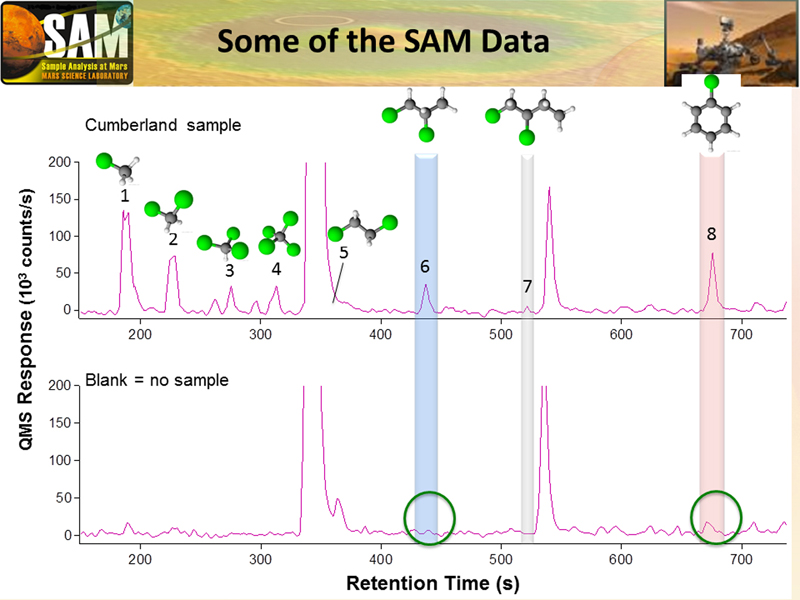Data graphed here are examples from the Sample Analysis at Mars (SAM) laborat...
Data graphed here are examples from the Sample Analysis at Mars (SAM) laboratory's detection of Martian organics in a sample of powder that the drill on NASA's Curiosity Mars rover collected from a rock target called "Cumberland." (Image credit: NASA/JPL-Caltech)
December 16, 2014
NASA Rover Finds Active and Ancient Organic Chemistry on Mars
Research Papers:
Mars methane detection and variability at Gale crater
by NASA research team
Science DOI: 10.1126/science.1261713
Published Online December 16 2014
Abstract
Reports of plumes or patches of methane in the Martian atmosphere that vary over monthly timescales have defied explanation to date. From in situ measurements made over a 20-month period by the Tunable Laser Spectrometer (TLS) of the Sample Analysis at Mars (SAM) instrument suite on Curiosity at Gale Crater, we report detection of background levels of atmospheric methane of mean value 0.69 ± 0.25 ppbv at the 95% confidence interval (CI). This abundance is lower than model estimates of ultraviolet (UV) degradation of accreted interplanetary dust particles (IDP’s) or carbonaceous chondrite material. Additionally, in four sequential measurements spanning a 60-sol period, we observed elevated levels of methane of 7.2 ± 2.1 (95% CI) ppbv implying that Mars is episodically producing methane from an additional unknown source.
(Probably just effluvia from the heated drill --Archimedes)
The imprint of atmospheric evolution in the D/H of Hesperian clay minerals on Mars
by NASA research team
Science DOI: 10.1126/science.1260291
Published Online December 16 2014
Abstract
The deuterium to hydrogen (D/H) ratio in strongly bound water or hydroxyl groups in ancient martian clays retains the imprint of the water of formation of these minerals. Curiosity’s Sample Analysis at Mars (SAM) experiment measured thermally evolved water and hydrogen gas released between 550°C and 950°C from samples of Hesperian era Gale crater smectite to determine this isotope ratio. The D/H value is 3.0 (±0.2) times the ratio in Standard Mean Ocean Water (SMOW). The D/H ratio in this ~3 billion year old mudstone that is half that of the present martian atmosphere but substantially higher than that expected in very early Mars indicates an extended history of hydrogen escape and desiccation of the planet.

